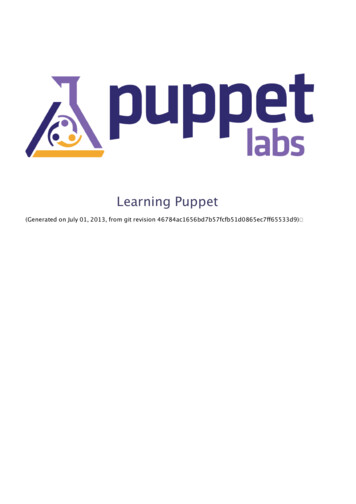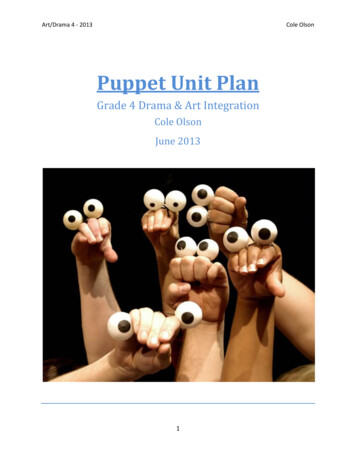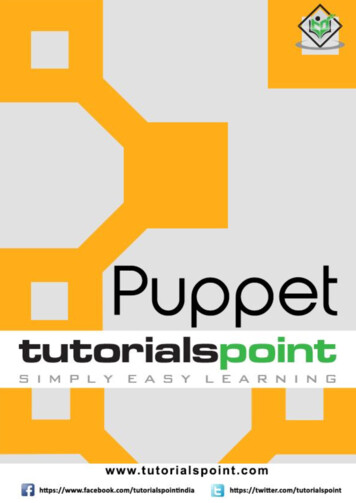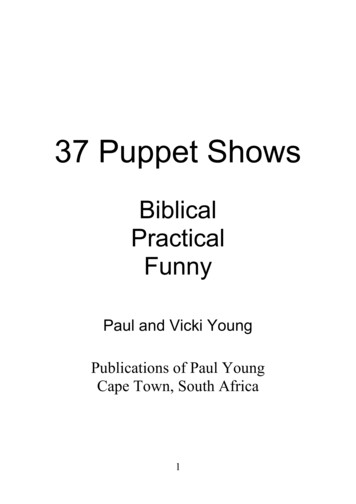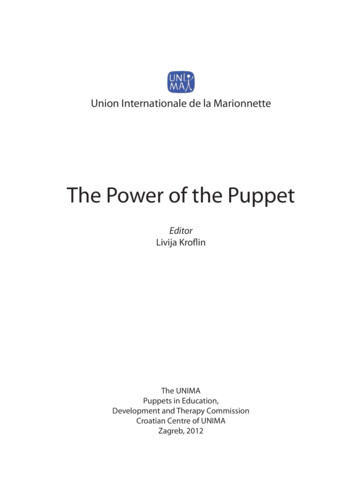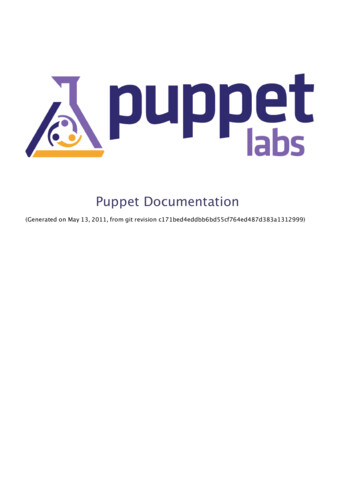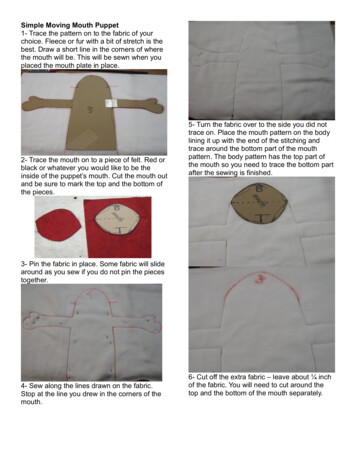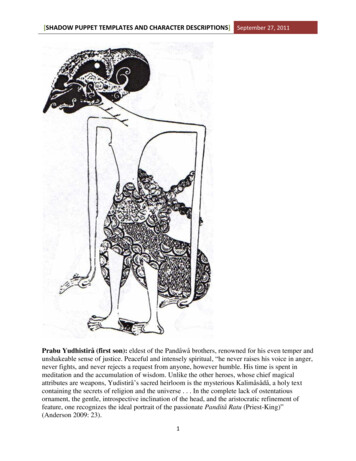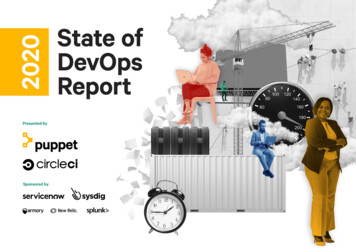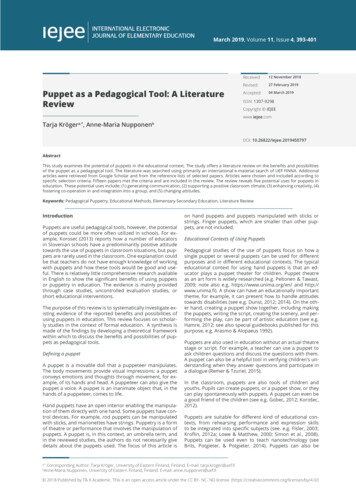
Transcription
March 2019, Volume 11, Issue 4, 393-401Puppet as a Pedagogical Tool: A LiteratureReviewReceived:12 November 2018Revised:27 February 2019Accepted:04 March 2019ISSN: 1307-9298Copyright IEJEEwww.iejee.comTarja Krögera,*, Anne-Maria NupponenbDOI: 10.26822/iejee.2019450797AbstractThis study examines the potential of puppets in the educational context. The study offers a literature review on the benefits and possibilitiesof the puppet as a pedagogical tool. The literature was searched using primarily an international e-material search of UEF FINNA. Additionalarticles were retrieved from Google Scholar and from the reference lists of selected papers. Articles were chosen and included according tospecific selection criteria. Fifteen papers met the criteria and are included in the review. The review reveals five potential uses for puppets ineducation. These potential uses include: (1) generating communication, (2) supporting a positive classroom climate, (3) enhancing creativity, (4)fostering co-operation in and integration into a group, and (5) changing attitudes.Keywords: Pedagogical Puppetry, Educational Methods, Elementary-Secondary Education, Literature ReviewIntroductionPuppets are useful pedagogical tools, however, the potentialof puppets could be more often utilized in schools. For example, Korosec (2013) reports how a number of educatorsin Slovenian schools have a predominantly positive attitudetowards the use of puppets in classroom situations, but puppets are rarely used in the classroom. One explanation couldbe that teachers do not have enough knowledge of workingwith puppets and how these tools would be good and useful. There is relatively little comprehensive research availablein English to show the significant benefits of using puppetsor puppetry in education. The evidence is mainly providedthrough case studies, uncontrolled evaluation studies, orshort educational interventions.The purpose of this review is to systematically investigate existing evidence of the reported benefits and possibilities ofusing puppets in education. This review focuses on scholarly studies in the context of formal education. A synthesis ismade of the findings by developing a theoretical frameworkwithin which to discuss the benefits and possibilities of puppets as pedagogical tools.Defining a puppetA puppet is a movable doll that a puppeteer manipulates.The body movements provide visual impressions: a puppetconveys emotions and thoughts through movement, for example, of its hands and head. A puppeteer can also give thepuppet a voice. A puppet is an inanimate object that, in thehands of a puppeteer, comes to life.Hand puppets have an open interior enabling the manipulation of them directly with one hand. Some puppets have control devices. For example, rod puppets can be manipulatedwith sticks, and marionettes have strings. Puppetry is a formof theatre or performance that involves the manipulation ofpuppets. A puppet is, in this context, an umbrella term, andin the reviewed studies, the authors do not necessarily givedetails about the puppets used. The focus of this article ison hand puppets and puppets manipulated with sticks orstrings. Finger puppets, which are smaller than other puppets, are not included.Educational Contexts of Using PuppetsPedagogical studies of the use of puppets focus on how asingle puppet or several puppets can be used for differentpurposes and in different educational contexts. The typicaleducational context for using hand puppets is that an educator plays a puppet theater for children. Puppet theatreas an art form is widely researched (e.g. Peltonen & Tawast,2009; note also e.g. https://www.unima.org/en/ and http://www.unima.fi). A show can have an educationally importanttheme, for example, it can present how to handle attitudestowards disabilities (see e.g. Dunst, 2012; 2014). On the other hand, creating a puppet show together, including makingthe puppets, writing the script, creating the scenery, and performing the play, can be part of artistic education (see e.g.Hamre, 2012; see also special guidebooks published for thispurpose, e.g. Arasmo & Alopaeus 1992).Puppets are also used in education without an actual theatrestage or script. For example, a teacher can use a puppet toask children questions and discuss the questions with them.A puppet can also be a helpful tool in verifying children's understanding when they answer questions and participate ina dialogue (Remer & Tzuriel, 2015).In the classroom, puppets are also tools of children andyouths. Pupils can create puppets, or a puppet show, or theycan play spontaneously with puppets. A puppet can even bea good friend of the children (see e.g. Gobec, 2012; Korošec,2012).Puppets are suitable for different kind of educational contexts, from rehearsing performance and expression skillsto be integrated into specific subjects (see. e.g. Fisler, 2003;Kroflin, 2012a; Lowe & Matthew, 2000; Simon et al., 2008).Puppets can be used even to teach nanotechnology (seeBrits, Potgieter, & Potgieter, 2014). Puppets can also beCorresponding Author: Tarja Kröger, University of Eastern Finland, Finland. E-mail: tarja.kroger@uef.fiAnne-Maria Nupponen, University of Eastern Finland, Finland. E-mail: anne.nupponen@uef.fia,*b 2018 Published by T& K Academic. This is an open access article under the CC BY- NC- ND license. (https://creativecommons.org/licenses/by/4.0/)
March 2019, Volume 11, Issue 4, 393-401used to deal with children with special needs. Nancy Renfro(1984), looking specifically at special needs children, arguesthat puppets build self-worth, encourage emotional release, and provide a visual substitute for verbal deficits anda textual substitute for visual impairments. Aronoff (2005,p.120) writes about special puppets made for demonstrating mouth movements, utilized in speech therapy. He alsorefers to collaboration between speech therapists and puppetry.In addition to short improvisations or planned shows, it ispossible to use puppets for long-term projects. For example, Gobec (2012) has introduced a holistic model for projectwork with a puppet, which combines diverse purposes. Forinstance, a project with a puppet could take a whole year,and it could connect diverse fields, such as science, art, culture, technique, media, communication, and ecology.MethodsThis study presents hand puppets as pedagogical tools andintroduces the results of a literature review. The review wasdriven by the following research question: What kinds ofbenefits and possibilities do puppets have in education?The literature review was primarily conducted using aninternational e-material search of UEF FINNA, which is asearch service of the University of Eastern Finland. Additional articles were retrieved from Google Scholar and fromthe reference lists of selected papers.tigations. Commentaries (see e.g. Belfiore, 2013) and projectdescriptions (see e.g. Bennett, 2002; Gobec, 2012) were notincluded. Duplicates and non-English language reports wereexcluded. Using these criteria, fifteen papers were identifiedas relevant to the current review. Table 2 provides a summary of papers that met the inclusion criteria.The reviewers systematically extracted the applicable information from each study after the studies that should beincluded in the review had been identified. Then the reviewers made a synthesis of the studies. This step involved combining the facts extracted from the studies using qualitativeanalysis.ResultsBased on our review of the literature, we identified five potential uses applied extensively in educational and learningcontexts. The five potential uses are presented here as thecomprehensive framework of a pedagogical puppet (see Figure 1), and each potential is given theoretical support fromthe literature. The potential uses are (1) generating communication, (2) supporting a positive classroom climate, (3) enhancing creativity, (4) fostering co-operation in and integration into a group, and (5) changing attitudes.The following keywords and combinations of keywords wereused: puppet* AND education; puppet* AND learning; puppet* AND teaching. The search was limited to abstracts inEnglish. A paper was selected if the abstract was judged todeal with the research question. Explicit criteria for specifying which studies to include in the review were developed(Table 1). All papers were selected independently by tworesearchers. Disagreements were resolved through discussion.Table 1. Inclusion criteria for the reviewCriterion typeInclusion criteriaTopicArticles must relate directly to the researchquestion above (benefits and possibilities ofpuppets in education).RecencyArticles should have been published between2000 and 2017.Age-rangeArticles should relate to school-age pupils(5–18).ContextArticles should relate to formal education:kindergarten or preprimary or primary orsecondary education.LanguageArticles should be written in English.Research baseArticles must be based on empirical research(either qualitative or quantitative).TransparencyThe methodology of the research on whichthe article is based must be explicit (e.g.sample sizes, instruments, analysis).To be included in the review, papers had to include empirical evidence relating to the impacts and outcomes of puppets as an educational tool or as a strategy in formal education. For example, puppets have been used in therapy(see e.g. Aronoff, 2005) and in children’s healthcare (see e.g.Tilbrook, Dwyer, Reid-Searl, & Parson, 2017), but such articles were excluded from this review because they did notdeal with formal education. To be included in the review,papers had to relate to school-age pupils (5-18); further, theterms "children" and "pupils" are used when it is referred toschool-age children and youths. Inclusion criteria requiredthat studies were peer-reviewed reports of empirical inves-394Figure 1. Potential uses for puppets. Pictures are from the website https://punomo.fi/.Generating communicationThe value of talk and communication in children’s learninghas been acknowledged since Vygotsky’s (1962) work on language and social interaction. In the school context, there iscommunication between teacher and pupil(s), as well as between children and between teachers. Communication notonly represents the transfer of information; it representsthe establishment of a relationship with the person to whomwe wish to transfer the information.Eleven studies in the data set (Ahlcrona, 2012; Brėdikytė,2002; Çağanağa & Kalmış, 2015; Hackling, Smith, & Murcia, 2011; Keogh, Naylor, Maloney, & Simon, 2008; Korošec,2012; Korošec, 2013; Maharani, 2016; Moriguchi, Sakata,Ishibashi, & Ishikawa, 2015; Remer & Tzuriel, 2015; Simon,Naylor, Keogh, Maloney, & Downing, 2008) highlight a puppet’s potential to generate communication. Puppets help (1)increase and improve classroom talk, (2) increase communication by creating a favourable, relaxed atmosphere, and (3)establish teacher-student interaction and children's mutualinteraction. We will treat these benefits in detail with help ofdata from literature below.
Puppet as a Pedagogical Tool: A Literature Review / Kröger & NupponenTable 2. Summary of literature reviewAuthors and yearResearch methodMain outcomeEnvironmentAhlcrona 2012Ethnographic approach: writtenobservations, conversations,photographs, and children’sdrawingsThe puppet is a mediating tool for children’scommunication and learning.Preschooleducation inSwedenBrėdikytė 2002Educational experiment: videotaped material, observationDialogical drama with pup-pets (DDP method)promotes the child’s creative self-expression,encourages the child’s independent dramaticplay, and stimulates verbal activity and creativityalong-side.Preschooleducation inLithuaniaÇağanağa and Kalmış2015Case study: observation andinterviewsPuppets are engaging and motivating in Englishlanguage learning.Kindergarten(pre-schoollearners) in CyprusDunst 2012Intervention and control groupdesignPuppetry can improve knowledge and changeattitudes toward persons with disabilities.Elementary schoolstudentsin USAFisler 2003Analysis of the projectPuppet theatre can provide an enjoyable methodof encouraging the development of reading skills.Elementary schoolin USAHackling, Smith andMurcia 2011Participatory action researchand design-based researchcollaboration: video record-ings,a questionnaire, field notes, andinter-viewsPuppets have a positive impact on student engagement and talk in science lessons.Primary school inAustraliaKeogh, Naylor,Maloney and Simon2008Case studyPuppets have a positive impact on children’sengagement and motivation in science lessons.Primary schoolin UKKorošec 2012Qualitative interpretative research: essays by teachersThe puppet is a medium for communication andpersonal interaction.Primary school inSloveniaKorošec 2013Descriptive and causal non-experimental method of educational researchTeachers believe puppets improve the communication and socialization in a class-room.Preschool andprimary schoolin SloveniaMaharani 2016Intervention and control groupdesignPuppetry is an effective media in teaching speaking English.Eighth-grade students in junior highschoolsin IndonesiaMehrotra, Khunyakari,Natarajan and Chunawala 2007The design-make-appraise(DMA) approach: observations,field notes, videotapes, andstudent writingsThe design and technology unit on puppetry canengage students in collaborative learning.Middle school students in IndiaMoriguchi, Sa-kata,Ishibashi and Ishikawa2015Intervention and control groupdesignInteraction with a doll or a puppet may have asignificant impact on the development of executive function.3- to 5-year-old children in pre-schoolin JapanRemer and Tzuriel2015Intervention: semi-structuredinterviewA puppet is a mediating tool that increases interest and motivation in learning.Kindergarten inIsraelSimon, Naylor, Keogh,Maloney and Downing2008Mixture of research methods:classroom observation, teacherand pupil interviews, and teachers’ reflective diariesThe use of puppets promotes engagement andtalk in science.Children aged 7-11in schools in UKWhiteland 2016Mixed methods case studyPuppet-making project together with older adultshelps children construct new mean-ing in theirunderstanding of aging and older adults.Elementary classroom in USAPuppets help teachers improve classroom talk. In thestudy by Simon, Naylor, Keogh, Maloney and Downing(2008), puppets were used in science lessons where apuppet had a problem that needed to be solved. Whenteachers used puppets, they were more likely to ask open,thought-provoking questions, which created opportunitiesfor the children to talk. The study contrasted this with conventional science lessons, which were more dominated byrecall questions. The use of puppets enabled the teachers to become more dialogic in their science teaching andintroducing puppets into the classroom influenced somefundamental aspects of their pedagogy. Several teachers noted how the children were fond of answering thepuppet's questions and expressing their thoughts. Puppets also fascinated those children who tended to remainaloof: “Many of the children who would not normally contribute to a discussion took a more proactive role” (Simonet al., 2008, p. 1243).Hackling, Smith, and Murcia (2011) examined a puppetproject and enhancing classroom discourse in primaryscience. Their findings are consistent with the researchof Simon, Naylor, Keogh, Maloney and Downing (2008).In Hackling’s et al. (2011) study, most teachers noted thatpuppets had a positive impact on student engagementand talk. Teachers indicated that increased numbers ofstudents participated in discussions, and students explained things more thoroughly to the puppet than to ateacher (Hackling et al., 2011).Keogh’s, Naylor’s, Maloney’s, and Simon’s (2008) study alsohad primary science lessons as the context, and it givesevidence of how the role of the puppet can help in generating communication. With a puppet in hand, a teachercan act ignorant:395
March 2019, Volume 11, Issue 4, 393-401The children empathised with the puppet. They understood theproblem that the puppet had, and they felt sorry for the puppetbecause it had the problem. [ ] They worked hard to articulateand explain their ideas to the puppet (who doesn’t understand),rather than for the teacher (who ‘knows all the answers and willknow what they mean even if they don’t explain well’). (Keogh etal., 2008, p. 146.)Keogh et al. (2008) note how a puppet does not have thesame status and authorship as a teacher, instead, it is viewedas a peer. A puppet acting as “the least knowledgeable member of the class” also helps children who are not confidentenough to talk about their ideas; they are more comfortabletalking to a puppet who does not know as much as they do.This increases communication in the classroom (Keogh etal., 2008). Simon et al. (2008) also report on puppets creatingconfidence. The puppet is regarded more as an equal, andit is less judgmental than the teacher is. Thus, it is easier totalk to a puppet (Simon et al., 2008).Remer and Tzuriel (2015) report how puppets help to broaden a discussion. When a puppet is used to bring personalexamples and experiences to a discussion, children are encouraged to add their examples and experiences. Remerand Tzuriel (2015) also note how a puppet can act as a rolemodel that teaches how to ask questions and to answer withexplanations.A puppet's ability to help children relax generates communication. Çağanağa and Kalmiş (2015) note that puppets canhelp in developing communicative skills especially becausechildren feel more relaxed when they talk with a puppet thanwith a teacher. Çağanağa and Kalmiş (2015, p. 8) write: “ theenjoyable atmosphere that the puppets create breaks downthe barriers between the teacher and the children.” Korošec(2012, p. 34) also notes the relation between relief and easycommunication: “A puppet in the hands of a teacher seemsto give relief. The child is relieved of his/her fear of authorityand can easily establish contact with the environment.”Maharani (2016) has compared Puppet media and Picturemedia in teaching speaking English. The findings reveal howusing puppets is more effective than using Picture media inteaching speaking because puppets are able to make students feel relaxed. Maharani (2016, p. 113) writes: “By usinga puppet, students become less inhibited when they are hidden behind the puppet by only handling it to move. The puppet is an ideal springboard for developing speaking skills.”Puppets are useful in establishing a teacher-student interaction. Korošec (2012) uses the notion “indirect communication” to describe a teacher who addresses students througha puppet. The teachers noted that puppets were a helpfultool in establishing contact with children and, in addition,improving their mutual communication (see also Korošec,2013). The puppet’s ability to attract and inspire childrenmade the communication and transfer of information easier. Puppets also helped establish spontaneous communication between students. An important finding is that thepuppet is a helpful tool in including shy children in communication (Korošec, 2012, p. 39–40): "For a shy child, the puppet represents protection from direct exposure and makesit easier for him/her to get spontaneously included into theactivity." In addition, Korošec (2012) notes how puppets helpchildren with learning and speaking difficulties to participatein communication.According to Ahlcrona (2012), a puppet can work as a “mediating tool” in communication between children and adults.Ahlcrona (2012, p. 180) explains it in the following way: “Itwas found that children interacting with the puppet communicated knowledge from different social practices andreflected their own experiences and perceptions againsta background of impressions from media, literature andeveryday life.” Ahlcrona (2012) also describes a puppet’s potential to generate unexpected discussion:396While conversations between the children and the puppet couldtake unexpected directions and twists, children initiated andcontrolled the content in a way that was not usual in other “normal” conversations. Such situations represent a way of makingroom for children’s voices and creating the opportunity for using language and communication in unusual and unexpectedways [ ]. (Ahlcrona, 2012, p. 181.)According to Remer and Tzuriel (2015, p. 362–363) a teachercan use a different language, which has a positive affect oncommunication: “The puppet allowed for direct communication with the children – mediators reported that the fact thepuppet portrayed the persona of a little girl allowed themto speak through her and use childish language, and in thismanner, created a form of direct ‘eye to eye’ communication.” Simon et al. (2008, p. 1244) also note the puppet's possibility to use a certain kind of language that affects communication positively: “Children felt that science lessons wereeasier to understand for a variety of reasons; the puppetsused simpler language than the teacher; the puppets spokemore slowly and explained more clearly; [ ].”Brėdikytė (2002) introduces the DDP (Dialogical Drama withPuppets) method in promoting a child-teacher interaction.In the DDP method, puppets are incorporated into the presentation of a fairy tale. Puppets and the fairy tale are employed, among others, to stimulate the children’s independent creativity. The teacher maintains a dialogue, and thusengages the children. The DDP method is a dialogue-basedmodel in which the child and the teacher act as partnersand build together a joint virtual reality. Brėdikytė (2002)describes it as “a new type of pedagogical interaction basedon dialogue.” It requires successful child-teacher interaction;Participating in the presentation [of a fairy-tale] together withthe teacher, the child as if “prepares himself” and “learns” howto replay it on his own. It is also asserted that any form of thechild’s active involvement and participation in a fairy-tale presentation leads him to its further replaying. Therefore, the teacher’s ability to establish individual contact with every child duringthe presentation is absolutely vital. (Brėdikytė, 2002, p. 39.)Remer and Tzuriel (2015) and Korošec (2012) report thatpuppets have benefits in testing situations by helping children reveal their knowledge.Teachers use puppet activities to test the knowledge of children,without the children being aware of that. We know that fearof exposure often prevents children from revealing all theirknowledge. Indirect communication with the puppet makesknowledge-testing easier. What is more, flexible teachers cantest children’s knowledge in informal and playful situations withpuppets. When children prepare a scene connected to a certaintopic, they will include all their knowledge and experiences fromthat field. (Korošec, 2012, p. 36.)Supporting positive classroom climateThe climate of a classroom has different dimensions. Evanset al. (2009) present three differentiable components ofthe classroom climate: academic (pedagogical and curricular elements of the learning environment), management(discipline styles for maintaining order), and an emotionalcomponent (affective interactions within the classroom).The emotional atmosphere includes psychological (level ofan individual) and social (level of a community) dimensions(see Hannula 2011; Laine et al., 2015). The psychologicaldimension of the emotional atmosphere (level of an individual) looks at the individual experiences that occur in theclass, such as emotions, thoughts, goals, beliefs, values, andmotivational orientations (Hannula, 2011; Laine et al., 2015).Ten studies in the data set (Ahlcrona, 2012; Çağanağa andKalmış, 2015; Fisler, 2003; Hackling, Smith, & Murcia 2011;Keogh, Naylor, Maloney, & Simon 2008; Korošec 2012; 2013;Maharani 2016; Remer & Tzuriel, 2015; Simon, Naylor, Keogh, Maloney & Downing 2008) bring forward puppets’ po-
Puppet as a Pedagogical Tool: A Literature Review / Kröger & Nupponentential to support a positive classroom climate. The datashows how puppets are helpful tools especially in twodimensions (see Evans et al. 2009): in classroom management and in supporting a positive emotional atmosphereon an individual level, such as in increasing motivation.The confidence of teachers can also benefit from usingpuppets. In Remer's and Tzuriel's (2015) study, mediatorsdescribe puppets helping them to raise their own self-confidence; a teacher can also use the puppet "as a type ofcover."Several studies (Çağanağa & Kalmış, 2015; Fisler, 2003;Keogh et al., 2008; Korošec, 2012; Maharani, 2016; Remer& Tzuriel, 2015; Simon et al., 2008) refer to the puppets’potential to generate motivation, interest, and attention.For example, Keogh et al. (2008, p. 146) report about thebenefit of puppets in generating motivation and interest in primary science lessons. A puppet with a problemgenerates motivation: " children were highly engaged bytheir conversations with the puppet, motivated to solvethe problem presented by the puppet, and eager to letthe puppet know what they had found out.” Fisler (2003)describes how a puppet theatre can provide an enjoyableway to encourage the development of reading skills:A puppet can provide an alternative attitude towards mistakes. Children are less embarrassed when they do notknow something if they have a puppet in hand; a puppetthat makes a mistake is funny (Korošec, 2012; see alsoSimon et al., 2008). Keogh et al. (2008) note how a puppet can be the one who knows the least in the classroom.Children who might be unsure about sharing their ideascan feel it more comfortable to participate when there isa puppet who does not know as much as they do (Simonet al., 2008).Evidence of reading development accompanied evidence ofexcitement and interest in reading as a creative act. The students [in elementary school] participated in activities combining these goals with the pleasures of making puppet theatre,as well as the opportunity to engage mathematical, visualart, oratorical, and movement skills, with consideration ofissues of identity construction in literary and, subsequently,performative representation. (Fisler, 2003, p. 36.)In Remer’s and Tzuriel’s (2015, p. 362) study, the puppet'sability to generate interest, attention, and motivation inthe children was the most frequently mentioned contribution of the puppet: “From their [the mediators’] description, it was apparent that the interest, attention andmotivation of children are intertwined. The effect of thepuppet on one of the factors, for the most part interest, instantly raised the others – attention and motivation.” Maharani’s (2016, p. 122) study reveals that puppet media ismotivating because it is something new for students: “[ ]since puppet media is a new media for the students, theunique interesting and joyful learning experience of puppet media make them more enthusiastic in the classroomactivities than monotonous learning media they used tobe using.”In Çağanağa's and Kalmış's (2015) study, teachers describehow puppets attract interest. Children are eager to participate in the lessons, and in the enjoyable environment thelearning is easy. Puppets make the children concentrate,which is helpful for the teachers. Korošec (2012, p. 42–43)describes the connection between generating motivationand attention in the following way:The puppet takes them [children] over and they focus all theirattention on communicating with it. Teachers are surprisedby the role of the puppet, as it supersedes their authority. Theanimated puppet draws the attention of children, who arewilling to do the work carefully and quickly for the puppet.(Korošec, 2012, p. 42–43.)In addition to motivating students, a puppet supports apositive emotional atmosphere with its ability to relaxstudents and help them participate. Korošec (2012) writesthat the puppet is a working partner that creates a specialatmosphere in the classroom by relaxing the children (seealso Korošec, 2013), releasing tension, and including everychild in the work. A puppet has an important role in theclassroom. Korošec (2012, p. 34) describes a puppet thataccompanies children throughout the year:Children confide in the puppet, have relaxed conversationswith it, they want to touch it and stroke it. They accept thepuppet as a live member of their group; they admire it andinclude it actively in their work. The puppet emotionally overwhelms children; it is their confidante and their ally. (Korošec,2012, p. 34.)A puppet can be a helpful tool when there is a need forcreating a comfortable atmosphere quickly. Keogh et al.(2008) remark how there is "an adjustment period" whena new teacher meets the children for the first time and before the relationship has been developed. When a puppetis used, the adjustment period can be remarkably shorter,and engagement can be generated quicker (Keogh et al.,2008). Korošec (2012) also notes how a puppet can makethe first meeting easier and help establish contact.In addition to creating a relaxed atmosphere, puppetscan make lessons fun (Korošec, 2012). Remer and Tzuriel(2015) report how puppets are able to add humor and create “a playful atmosphere.” In their study, the mediatorsdescribe how the puppets influence creating a cheerful atmosphere in the group and making children laugh a lot. InSimon's et al. (2008) study, children commented on havingfun with puppets: enjoyment and engagement were seento have a strong connection in many interviews.A puppet can provide a lookout on children's feelings. Korošec (2012) notes how a puppet can be a teacher's toolin getting to know the children and establishing individual relationships with them. When children express theirfeelings through puppet activities, the puppet enablesthe teacher to notice such feelings and experiences thatwould have gone unrecognized. Negative emotions can beexpressed with a puppet in an acceptable way (Korošec,2012). Korošec (2012) describes how a puppet can tra
Defining a puppet A puppet is a movable doll that a puppeteer manipulates. The body movements provide visual impressions: a puppet conveys emotions and thoughts through movement, for ex-ample, of its hands and head. A puppeteer can also give the puppet a voice. A puppet is an inanimate
